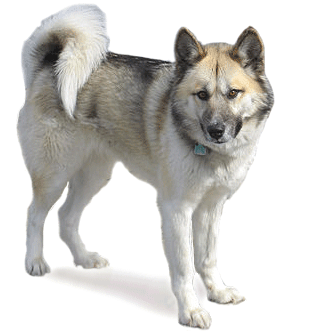Type the name of the breed you're looking for below
[wpdreams_ajaxsearchlite] Don't see the breed your're looking for? Click here and let us know!
Breed Characteristics
1 paw - breed exhibits the least amount of this characteristic
5 paws - breed exhibits most amount of this characteristic
Greenland Dog
| Other Names | Kalaallit qimmiat (Qimmeq), Grønlandshund, Grünlandshund, Esquimaux Dog, Greenland Husky |
| Country of Origin | Greenland |
| Weight | 66 - 70 lbs. (30 - 32 kg) |
| Height (at withers) | 22 - 25 in. (56 - 64 cm) |
| Coat | Its coat is of medium length and consists of two layers. The inner layer consists of short wool-like fur, the outer layer of longer, coarser, water-repellent fur. |
| Colour | They come in all colours. |
| Litter Size | 4 - 8 puppies, average 6 |
| Life Span | 12 - 14 years |
| Origin & History | The Greenland Dog (Danish: Grønlandshunden, also known as Greenland Husky) is a large breed of husky-type dog kept as a sled dog and for hunting polar bear and seal. This is an ancient breed, thought to be directly descended from dogs brought to Greenland by the first Inuit settlers. The Greenland Dog originates from the coastal area of the Arctic regions of Northern Siberia, Alaska, Canada and Greenland. Archaeological evidence has proven the dog first reached Greenland with the Sarqaq people between 4000 and 5000 years ago. Sundry artifacts found within the Inuit people's areas confirm that the Inuit people, along with their sledges and dogs originated from Siberia. Remains have been found in the New Siberian Islands that have been carbon dated to around 7000 BC. This makes the Greenland dog one of the oldest breeds in the world. The Vikings were the first Europeans to settle in Greenland and subsequently became aware of these dogs. Then others like the early European whalers, explorers and fur traders in Canada and North America trained dog-sledding skills from the natives of the Arctic region, and used with great success the Greenland dog when hunting, exploring and traveling across the Arctic regions. Greenland dogs belong to the Spitz breeds, a group of dogs characterized by their prick ears, curly tails and thick coats and are among the oldest known dog breeds in the world today. The Greenland dog has been a draught animal in the Arctic regions for centuries and consequently they have developed a powerful body and heavy coats, with a natural capacity for load pulling and endurance in a harsh working environment. It is thought that the first dogs were brought to Britain around 1750; an Esquimaux bitch was exhibited at one of the earliest dog shows held in Darlington on 29 July 1875, which was reported in the Live Stock Journal and Fanciers Gazette published on the 6th of August 1875. They were recognized by the Kennel Club at its foundation in 1880. Greenland dogs have been used on many expeditions by explorers, the most famous being Fridtjof Nansen. Nansen recorded in his book På ski over Grønland, Greenland dogs being used as working dogs by the Greenland Native. Nansen was a successful polar explorer and used the dogs on his famous voyage across the arctic ocean in the equally famous ship Fram. Roald Amundsen used the Greenland Dogs as well on his expedition to the Antarctic. Amundsen carefully chose 97 Greenland dogs to accompany him and his team on his expedition to Antarctica and in his subsequent South Pole expedition. Both men started with more dogs than they technically needed to pull as sledge, intending to feed the weakest dogs to the strong ones during the voyage. |
| Personality | Aloof and very independent, the Greenland Dog can be loving with an owner he bonds with. The breed remains principally a working dog. It has the typical Nordic, good, loyal temperament, but when the dogs work in teams, they do not have the opportunity to develop a relationship with one master. They are independent, self-willing, rowdy and boisterous in their play. This dog is not content to simply lie around the house all day long; the Greenland Dog needs to work or have some kind of vigorous activity. In recent times it has become more popular in Norway and Sweden as a hiking companion. This breed also lives with the Eskimos and shares the hardships the Eskimos face. They pull sleds and help with the hunt for bears and seals. They are usually friendly toward people and have no guarding or protector instincts, but their hunting skills are very developed. Training these dogs is very difficult and it takes a lot of firm, patient leadership to teach the dog the most necessary skills. This breed still retains a lot of wolf instincts and character. Their alpha pack instinct is very strong. An owner of a Greenland Dog must be very dominant and able to show the dog he is alpha. The dogs must accept the owner as the leader. This breed likes to roam. Greenland Dogs are also seen in dog racing with sleds or wagons. |
Care Requirements
| Health | There are no known breed-specific health concerns. |
| Grooming | Brush occasionally. |
| Exercise | The Greenland Dog is not a breed to contently lie around your house. It needs to be taken on a daily, long brisk walk, and needs to have a job to do. While out on the walk make sure the dog heels beside or behind the person holding the lead, never in front, as instinct tells a dog the leader leads the way, and that leader needs to be the human. |
| Other Considerations | The Greenland Dog is not good for apartment life. It needs space, room to run and a job to do. This breed can live outdoors. It can withstand cold temperatures and does not like excessive heat. |



